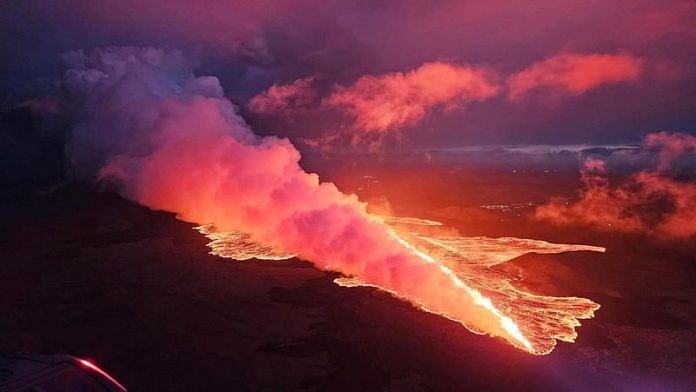COPENHAGEN (Reuters) -Iceland’s Reykjanes peninsula has seen a string of volcanic eruptions since 2021 when geological systems dormant for around 800 years became active again.
Experts say the region, just south of the capital Reykjavik and home to 30,000 people, could experience so-called fissure eruptions repeatedly for several centuries.
Following is a timeline of recent eruptions:
AUG. 22, 2024
An eruption at Sundhnukar crater on the Reykjanes peninsula spewed glowing hot lava and smoke into the night sky around midnight with a fissure length of around 3.9 km (2.42 miles).
The nearby area was evacuated although the lava was not flowing towards the nearby fishing town Grindavik.
MAY 29, 2024
The eruption near Hagafell on the Reykjanes peninsula lasted for 24 days leaving a large area covered in solidified lava.
The eruption was the most powerful since the volcanic system became active again three years earlier. Lava fountains reached a height of 50 metres (164 feet) and a fissure length of at least 3.4 km.
MARCH 16, 2024
The eruption between the Hagafell and Store-Skogfell peaks lasted for 54 days, making it the second-longest on the Reykjanes peninsula since 2021.
It erupted in the same area as the previous outburst and spewed smoke, molten rock and bright orange lava from an estimated 3 km fissure.
FEB. 8, 2024
This eruption lasted roughly a day, with lava spewing 80 m high from a 3 km crack.
Lava flows damaged pipelines after which hot water supply used to warm homes was cut off during freezing winter temperatures. The Blue Lagoon closed after lava covered a road.
JAN. 14, 2024
The eruption lasted two days, and the lava flow reached the outskirts of Grindavik, home to nearly 4,000 residents, setting three houses alight.
DEC. 18, 2023
An eruptionin the Svartsengi volcanic system near Grindavik sent lava and smoke across a wide area after weeks of intense earthquake activity. A roughly 4-km long crack in the ground stretched towards Grindavik.
JULY 10, 2023
The small eruption of the Litli Hrutur volcanic system, some 60 km from the capital, resulted in gas pollution from lava, though it was far from any densely populated areas.
AUG. 3, 2022
The three-week eruption in the Fagradalsfjall volcanic system started after days of earthquake activity. Due to poisonous gases, tourists and residents were asked to avoid the area and a “code red” stopped airplanes flying over the site.
MARCH 19, 2021
Lava fountains erupted from a 500 to 750 meters long fissure in the Fagradalsfjall system. Volcanic activity in the area continued for six months, prompting thousands of tourists to visit.
More than 40,000 earthquakes occurred on the peninsula in the month leading up to the eruption, a huge jump from the 1,000 to 3,000 earthquakes each year since 2014.
(Reporting by Isabelle Yr Carlsson; Editing by Andrew Cawthorne, Jonathan Oatis and Tomasz Janowski)
Disclaimer: This report is auto generated from the Reuters news service. ThePrint holds no responsibilty for its content.



